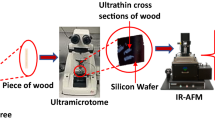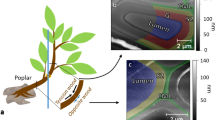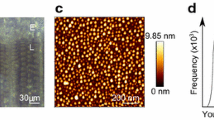Abstract
Main conclusion
AFM measurements on spruce sample cross-sections reveal that the structural appearance of the S2 layer changes from a network structure to a concentric lamellar texture depending on the cutting angle.
The structural assembly of wood constituents within the secondary cell wall has been subject of numerous studies over the last decades, which has resulted in contradicting models on the spatial arrangement and orientation of the wood macromolecules. Here, we use multichannel atomic force microscopy by means of quantitative imaging, to gain new insights into the macromolecular assembly. Cross-sections of spruce wood, which had been cut at different angles ranging from 0° to 30° were investigated. Strikingly, depending on the cutting angle, the structural appearance of the S2 layer changed from a network-like structure to a distinct concentric lamellar texture. This makes us conclude that the often visualized lamellar organization of the secondary cell wall is not the consequence of a continuous inherent ring pattern, but rather a result of the specific surface cross-section appearance of cellulose aggregates at larger cutting angles. By analyzing the recorded force distance curves in every pixel, a nano-mechanical characterization of the secondary cell wall was conducted. Substantially lower indentation modulus values were obtained compared to nanoindentation values reported in the literature. This is potentially due to a smaller interaction volume of the probe with a by far less deep indentation.







Similar content being viewed by others
Abbreviations
- AFM:
-
Atomic force microscopy
- CML:
-
Compound middle lamella
- SNOM:
-
Scanning near-field microscopy
- TEM:
-
Transmission electron microscopy
- MFA:
-
Microfibril angle
- NI:
-
Nanoindentation
- QI™:
-
Quantitative imaging
References
Arnould O, Arinero R (2015) Towards a better understanding of wood cell wall characterisation with contact resonance atomic force microscopy. Compos Part A Appl S 74:69–76
Arnould O, Siniscalco D, Bourmaud A, Le Duigou A, Baley C (2017) Better insight into the nano-mechanical properties of flax fibre cell walls. Ind Crop Prod 97:224–228
Barber NF, Meylan BA (1964) The anisotropic shrinkage of wood. A theoretical model. Holzforschung 18:146–156
Bergander A, Brändström J, Daniel G, Salmén L (2002) Fibril angle variability in earlywood of Norway spruce using soft rot cavities and polarization confocal microscopy. J Wood Sci 48:255–263
Brändström J (2001) Micro- and ultrastructural aspects of norway spruce tracheids: a review. IAWA J 22(4):333–353
Burgert I, Dunlop JWC (2011) Micromechanics of cell walls, vol 9. Springer, Berlin, pp 27–52
Burgert I, Keplinger T (2013) Plant micro- and nanomechanics: experimental techniques for plant cell-wall analysis. J Exp Bot 64(15):4635–4649
Burgert I, Frühmann K, Keckes J, Fratzl P, Stanzl-Tschegg SE (2003) Microtensile testing of wood fibers combined with video extensometry for efficient strain detection. Holzforschung 57:661–664
Casdorff K, Keplinger T, Burgert I (2017) Nano-mechanical characterization of the wood cell wall by AFM studies: comparison between AC- and QI™ mode. Plant Methods 13(1):60
Chopinet L, Formosa C, Rols MP, Duval RE, Dague E (2013) Imaging living cells surface and quantifying its properties at high resolution using AFM in QI™ mode. Micron 48:26–33
Derjaguin BV, Muller VM, Toporov YP (1975) Effect of contact deformations on adhesion of particles. J Colloid Interf Sci 53:314–326
Donaldson LA (2001) A three-dimensional computer model of the tracheid cell wall as a tool for interpretation of wood cell wall ultrastructure. IAWA J 22(3):213–233
Donaldson L (2007) Cellulose microfibril aggregates and their size variation with cell wall type. Wood Sci Technol 41(5):443–460
Donaldson LA, Xu P (2005) Microfibril orientation across the secondary cell wall of Radiata pine tracheids. Trees-Struct Funct 19(6):644–653
Eder M, Arnould O, Dunlop JWC, Hornatowska J, Salmén L (2013) Experimental micromechanical characterisation of wood cell walls. Wood Sci Technol 47(1):163–182
Fahlén J, Salmén L (2002) On the lamellar structure of the tracheid cell wall. Plant Biol 4:339–345
Fengel D, Wegener G (1984) Wood chemistry, ultrastructure, reactions. Walter de Gruyter, Berlin
Fratzl P, Burgert I, Gupta HS (2004) On the role of interface polymers for the mechanics of natural polymeric composites. Phys Chem Chem Phys 6(24):5575–5579
Frybort S, Obersriebnig M, Muller U, Gindl-Altmutter W, Konnerth J (2014) Variability in surface polarity of wood by means of AFM adhesion force mapping. Colloid Surface A 457:82–87
Gibson LJ, Ashby MF (2001) Cellular solids. Structure and properties. Cambridge University Press, Cambridge
Gindl W, Gupta HS, Schöberl T, Lichtenegger HC, Fratzl P (2004) Mechanical properties of spruce wood cell walls by nanoindentation. Appl Phys A 79(8):2069–2073
Hodzic A, Stachurski ZH, Kim JK (2000) Nano-indentation of polymer-glass interfaces Part 1. Experimental and mechanical analysis. Polymer 41:6895–6905
Jäger A, Hofstetter K, Buksnowitz C, Gindl-Altmutter W, Konnerth J (2011) Identification of stiffness tensor components of wood cell walls by means of nanoindentation. Compos Part A Appl S 42(12):2101–2109
Jakes JE, Frihart CR, Beecher JF, Moon RJ, Resto PJ, Melgarejo ZH, Suárez OM, Baumgart H, Elmustafa AA, Stone DS (2011) Nanoindentation near the edge. J Mater Res 24(03):1016–1031
Jin X, Kasal B (2016) Adhesion force mapping on wood by atomic force microscopy: influence of surface roughness and tip geometry. Roy Soc Open Sci 3(10):160248
Keplinger T, Konnerth J, Aguié-Béghin V, Rüggeberg M, Gierlinger N, Burgert I (2014) A zoom into the nanoscale texture of secondary cell walls. Plant Methods 10 (1)
Kerr AJ, Goring DAI (1975) The ultrastructural arrangement of the wood cell wall. Cell Chem Technol 9:563–573
Kerstens S, Decraemer WF, Verbelen JP (2001) Cell walls at the plant surface behave mechanically like fiber-reinforced composite materials. Plant Physiol 127(2):381–385
Konnerth J, Gierlinger N, Keckes J, Gindl W (2009) Actual versus apparent within cell wall variability of nanoindentation results from wood cell walls related to cellulose microfibril angle. J Mater Sci 44(16):4399–4406
Lee S-H, Wang S, Pharr GM, Xu H (2007) Evaluation of interphase properties in a cellulose fiber-reinforced polypropylene composite by nanoindentation and finite element analysis. Compos Part A Appl S 38(6):1517–1524
Muraille L, Aguié-Béghin V, Chabbert B, Molinari M (2017) Bioinspired lignocellulosic films to understand the mechanical properties of lignified plant cell walls at nanoscale. Sci Rep-U 7:1–11
Radotic K, Simic-Krstic J, Jeremic M, Trifunovic M (1994) A study of lignin formation at the molecular level by scanning tunneling microscopy. Biophys J 66:1763–1767
Reiterer A, Lichtenegger H, Tschegg S, Fratzl P (1999) Experimental evidence for a mechanical function of the cellulose microfibril angle in wood cell walls. Philos Mag A 79(9):2173–2184
Rettler E, Hoeppener S, Sigusch BW, Schubert US (2013) Mapping the mechanical properties of biomaterials on different length scales: depth-sensing indentation and AFM based nanoindentation. J Mater Chem B 1(22):2789–2806
Reza M, Ruokolainen J, Vuorinen T (2014) Out-of-plane orientation of cellulose elementary fibrils on spruce tracheid wall based on imaging with high-resolution transmission electron microscopy. Planta 240(3):565–573
Ruel K, Barnould F, Goring DAI (1978) Lamellation in the S2 layer of softwood tracheids as demonstrated by scanning transmission electron microscopy. Wood Sci Technol 12:287–291
Rüggeberg M, Saxe F, Metzger TH, Sundberg B, Fratzl P, Burgert I (2013) Enhanced cellulose orientation analysis in complex model plant tissues. J Struct Biol 183(3):419–428
Sader JE, Chon JWM, Mulvaney P (1999) Calibration of rectangular atomic force microscope cantilevers. Rev Sci Instrum 70(10):3967–3969
Schwarze FWMR, Engels J (1998) Cavity formation and the exposure of peculiar structures in the secondary wall (S2) of tracheids and fibres by wood degrading Basidiomycetes. Holzforschung 52:117–123
Sell J, Zimmermann T (1993) Radial fibril agglomerations of the S2 on transverse-fracture surfaced of tracheids of tension-loaded spruce and white fir. Holz Roh Werkst 51:384
Sell J, Zimmermann T (1998) The fine structure of the cell wall of hardwoods on transverse-fracture surfaces. Holz Roh Werkst 56:365–366
Singh AP, Daniel G (2001) The S2 layer in the tracheid wall of Picea abies wood: inhomogeneity in lignin distribution and cell wall microstructure. Holzforschung 55:373–378
Terashima N, Awano T, Takabe K, Yoshida M (2004) Formation of macromolecular lignin in ginkgo xylem cell walls as observed by field emission scanning electron microscopy. C R Biol 327(9–10):903–910
Tsukruk VV, Singamani S (2012) Scanning probe microscopy of soft matter: fundamentals and practice. Wiley, London
Wimmer R, Lucas BN, Tsui TY, Oliver WC (1997) Longitudinal hardness and Young’s modulus of spruce tracheid secondary walls using nanoindentation technique. Wood Sci Technol 31:131–141
Zimmermann T, Eckstein JSD (1994) Rasterelektronenmikroskopische Untersuchung an Zugbruchflächen von Fichtenholz. Holz Roh Werkst 52:223–229
Zimmermann T, Thommen V, Reimann P, Hug HJ (2006) Ultrastructural appearance of embedded and polished wood cell walls as revealed by atomic force microscopy. J Struct Biol 156(2):363–369
Acknowledgements
The authors thank Thomas Schnider for cutting the wood samples. Valuable discussion with John Berg is acknowledged.
Author information
Authors and Affiliations
Corresponding author
Ethics declarations
Conflict of interest
The authors declare that they have no conflict of interest.
Electronic supplementary material
Below is the link to the electronic supplementary material.
Rights and permissions
About this article
Cite this article
Casdorff, K., Keplinger, T., Rüggeberg, M. et al. A close-up view of the wood cell wall ultrastructure and its mechanics at different cutting angles by atomic force microscopy. Planta 247, 1123–1132 (2018). https://doi.org/10.1007/s00425-018-2850-9
Received:
Accepted:
Published:
Issue Date:
DOI: https://doi.org/10.1007/s00425-018-2850-9




